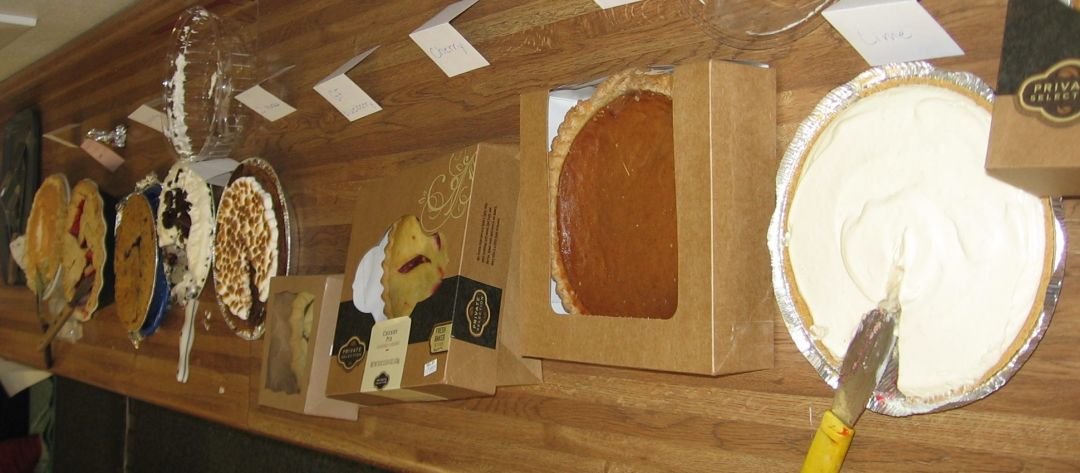[et_pb_section bb_built=”1″ admin_label=”section”][et_pb_row admin_label=”row”][et_pb_column type=”4_4″][et_pb_text admin_label=”Text” background_layout=”light” text_orientation=”left” use_border_color=”off” border_color=”#ffffff” border_style=”solid”]
 Math holidays are few and far between, so when Pi Day rolls around, our math classes celebrate! It takes place on March 14 (3-14). Pi is the ratio of a circle’s circumference to its diameter. The quantity pi is not some strange number that appears in math formulas; it is a naturally occurring and universal ratio and it holds true for any circle. We spend time learning about circles and their parts (diameter, radius, circumference). Drawing compasses are put out for students to practice perfecting their circles. We read the book Sir Cumference and the Dragon of Pi and we learn pi trivia e.g., which famous mathematician was born on Pi Day? Albert Einstein, who was born in 1879. Each student receives a pi pencil, as they love to try to memorize as many digits as possible. The part of pi day that students are the most excited about is eating pie. Parents help us by sending in a wonderful variety of pies for us to share. Before we cut the pies, we relate the pieces to fractions: if I cut the pie into 8 equal pieces, what is the name for 2 pieces? (2/8ths or 1/4th) What is half of an eighth? (1/16th). We find ways to get a tremendous amount of math out of pies. We finish our circle unit by measuring a variety of round objects, so that students can see how/where pi occurs. Students measure each object’s diameter and circumference. They multiply the diameter by pi (3.14) and the answer should match the circumference they measured: Diameter x Pi = Circumference (of all circles). An alternative application is to measure the circumference and the diameter. When the circumference is divided by the diameter, the result should be pi/3.14. This is the ratio of a circle’s circumference to its diameter and where the power of pi lies. This activity gives them the opportunity to use pi and to experience how this special number relates to circles in the real world: to see that the distance around a circle is a little more than three times as long as its diameter. In the 4th and 5th grades, students are beginning to understand the idea of a constant number such as pi. The fact that it is never-ending and that no discernible pattern or sequence of numbers within it has been found is hard for anyone to grasp, but is also what makes this number so fascinating and mysterious to us all. All in all, we had a wonderful Pi Day!
Math holidays are few and far between, so when Pi Day rolls around, our math classes celebrate! It takes place on March 14 (3-14). Pi is the ratio of a circle’s circumference to its diameter. The quantity pi is not some strange number that appears in math formulas; it is a naturally occurring and universal ratio and it holds true for any circle. We spend time learning about circles and their parts (diameter, radius, circumference). Drawing compasses are put out for students to practice perfecting their circles. We read the book Sir Cumference and the Dragon of Pi and we learn pi trivia e.g., which famous mathematician was born on Pi Day? Albert Einstein, who was born in 1879. Each student receives a pi pencil, as they love to try to memorize as many digits as possible. The part of pi day that students are the most excited about is eating pie. Parents help us by sending in a wonderful variety of pies for us to share. Before we cut the pies, we relate the pieces to fractions: if I cut the pie into 8 equal pieces, what is the name for 2 pieces? (2/8ths or 1/4th) What is half of an eighth? (1/16th). We find ways to get a tremendous amount of math out of pies. We finish our circle unit by measuring a variety of round objects, so that students can see how/where pi occurs. Students measure each object’s diameter and circumference. They multiply the diameter by pi (3.14) and the answer should match the circumference they measured: Diameter x Pi = Circumference (of all circles). An alternative application is to measure the circumference and the diameter. When the circumference is divided by the diameter, the result should be pi/3.14. This is the ratio of a circle’s circumference to its diameter and where the power of pi lies. This activity gives them the opportunity to use pi and to experience how this special number relates to circles in the real world: to see that the distance around a circle is a little more than three times as long as its diameter. In the 4th and 5th grades, students are beginning to understand the idea of a constant number such as pi. The fact that it is never-ending and that no discernible pattern or sequence of numbers within it has been found is hard for anyone to grasp, but is also what makes this number so fascinating and mysterious to us all. All in all, we had a wonderful Pi Day!
[/et_pb_text][et_pb_team_member admin_label=”Person” name=”Kitty Cary” position=”4th/5th Grade: Math; Handwriting/Keyboarding; 4th/5th Grade: Group Time” image_url=”https://dev.bixbyschool.org/wp-content/uploads/2016/08/2BW8020-50-150×150.jpg” animation=”off” background_layout=”light” use_border_color=”off” border_color=”#ffffff” border_style=”solid”] [/et_pb_team_member][/et_pb_column][/et_pb_row][/et_pb_section]




